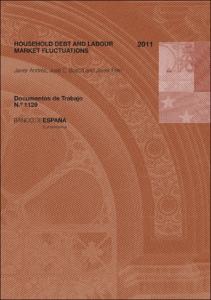Registro completo de metadatos
| Campo DC | Valor |
|---|---|
| dc.contributor.author | Andrés, Javier |
| dc.contributor.author | Boscá, José Emilio |
| dc.contributor.author | Ferri, Javier |
| dc.coverage.spatial | Estados Unidos |
| dc.date.accessioned | 2019-08-10T18:00:18Z |
| dc.date.available | 2019-08-10T18:00:18Z |
| dc.date.issued | 2011-11-18 |
| dc.identifier.issn | ISSN: 0213-2710 (en papel) |
| dc.identifier.issn | ISSN: 1579-8666 (en línea) |
| dc.identifier.uri | https://repositorio.bde.es/handle/123456789/7083 |
| dc.description.abstract | Las correlaciones de la productividad del trabajo con el output, el total de horas trabajadas, las vacantes y el desempleo han cambiado desde 1980 en Estados Unidos. En este trabajo se propone una explicación para estos y otros cambios en las fluctuaciones de las variables laborales basado en el comportamiento de la oferta de trabajo tras la desregulación del mercado hipotecario que ha llevado a un fuerte incremento del endeudamiento de las familias durante los últimos veinte años. Utilizamos para ello un modelo de búsqueda con negociación eficiente en el que los consumidores impacientes pueden endeudarse hasta un máximo que viene dado por una fracción del valor esperado de su propiedad inmobiliaria. Conforme aumenta la capacidad de endeudamiento de los hogares también lo hace el impacto de los shocks tecnológicos sobre la utilidad marginal del consumo, lo que redunda en la reducción de las horas por trabajador y en un aumento del salario negociado. Esto a su vez reduce el incentivo de las empresas a abrir nuevas vacantes mitigando el impacto positivo de dicho shock sobre el empleo |
| dc.description.abstract | The co-movements of labor productivity with output, total hours, vacancies and unemployment have changed since the mid 1980s. This paper offers an explanation for the sharp break in the fluctuations of labor market variables based on endogenous labor supply decisions following the mortgage market deregulation. Our exercise shows that the dynamic pattern of the labor market variables might have been substantially affected by the increase in household leverage in the US in the last twenty years. We set up a search model with efficient bargaining and financial frictions, in which impatient borrowers can take an amount of credit that cannot exceed a proportion of the expected value of their real estate holdings. When borrowers’ equity requirements are low, the impact of a positive technology shock on the marginal utility of consumption is strengthened, which in turn results in lower hours per worker and higher wages in the bargaining process. This shift in labor supply discourages fi rms from opening vacancies, reducing the impact of the shock on employment |
| dc.format.extent | 37 p. : fórmulas, gráf., tab. |
| dc.language.iso | eng |
| dc.publisher | Banco de España |
| dc.relation.ispartof | Documentos de Trabajo / Banco de España, 1129 |
| dc.rights | Reconocimiento-NoComercial-CompartirIgual 4.0 Internacional (CC BY-NC-SA 4.0) |
| dc.rights | In Copyright - Non Commercial Use Permitted |
| dc.rights.uri | https://creativecommons.org/licenses/by-nc-sa/4.0/deed.es_ES |
| dc.rights.uri | http://rightsstatements.org/vocab/InC-NC/1.0/ |
| dc.subject | Ciclo económico |
| dc.subject | Mercado laboral |
| dc.subject | Restricciones crediticias |
| dc.subject | Business cycle |
| dc.subject | Labor market |
| dc.title | Household debt and labour market fluctuations |
| dc.type | Documento de trabajo |
| dc.identifier.bdebib | 000341372 |
| dc.identifier.bdepub | DTRA-201129-eng |
| dc.subject.bde | Empleo, desempleo, salarios |
| dc.subject.bde | Fluctuaciones y ciclos económicos |
| dc.subject.bde | Crédito y mercado hipotecario |
| dc.publisher.bde | Madrid : Banco de España, 2011 |
| dc.subject.jel | E24 |
| dc.subject.jel | E32 |
| dc.subject.jel | E44 |












